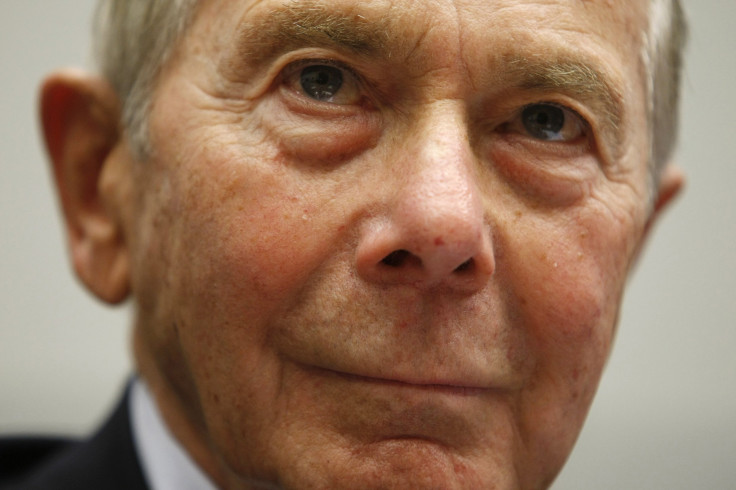Judge’s Ruling On Government's AIG Takeover Leaves Some Bailout Questions Unanswered

On Sept. 16, 2008, American International Group was burning. The insurance company’s reckless bets on the subprime mortgage market had gone up in smoke, and the firm faced either government rescue or bankruptcy. As then-Federal Reserve chairman Ben Bernanke later wrote, “The Federal Reserve was the only fire station in town.”
Seven years later, a judge has found that the government’s bailout of AIG left the company smoldering. Judge Thomas Wheeler of the United States Court of Federal Claims ruled Monday that the government -- and the Federal Reserve Bank of New York -- overreached when they effectively nationalized AIG in 2008. The decision, however, raises as many questions as it settles -- particularly around the issue of government bailouts. Namely: how far can the government go to right a ship that's quickly sinking? And where does that authority lie?
Even as Judge Wheeler ruled that the government lacked the authority to seize a 79.9 percent stake in the flailing company, he declined to award the $40 billion in damages former AIG CEO Maurice “Hank” Greenberg sought for himself and other shareholders. The ruling complicated the post-crisis reckoning, Judge Wheeler admitted. “A troubling feature of this outcome is that the government is able to avoid any damages notwithstanding its plain violations of the Federal Reserve Act,” he wrote, referring to the 1932 statute that empowers the Fed to extend credit in a crisis.
The Brookings Institution’s Philip Wallach sees Judge Wheeler’s language as "strikingly sympathetic" to the plaintiffs but still not enough to alter the Fed. “He’s trying to lay out some strong language to limit the Fed,” said Wallach, whose research explores the legal fallout of crisis-era bailouts. “On the other hand, there’s the zero-dollar judgment, which seems like it will inevitably cause the Fed to view this as a slap on the wrist.”
Wheeler, who was appointed by President Bush in 2005, acknowledged as much. “Any time the government saves a private enterprise from bankruptcy through an emergency loan, as here, it can essentially impose whatever terms it wishes without fear of reprisal.”
The 90-year-old Greenberg sought monetary damages on the argument that the government harmed shareholders and violated the Fifth Amendment when it essentially took the helm at AIG. Though Judge Wheeler agreed that the bailout constituted an “illegal exaction,” he could not justify damages.
That’s because the alternative to the government bailout, as Bernanke and then-Treasury Secretary Timothy Geithner knew, was bankruptcy -- which would have left shareholders penniless. As a financial advisor told AIG’s board in 2008: “Twenty percent of something is better than 100 percent of nothing.”
The Federal Reserve said as much in a statement released Monday. “The terms of the credit were appropriately tough to protect taxpayers from the risks the rescue loan presented when it was made,” the statement read, calling its actions “legal, proper and effective.”
The terms were indeed tough. AIG faced interest rates more than three times what the Fed normally offers. Hundreds of government officials and advisers swarmed the firm to monitor compliance. The CEO got the boot. To Judge Wheeler, the Fed’s response was “unduly harsh.”
In part, that’s because Fed officials hoped to use the penalties to avoid “moral hazard,” the idea that companies are more likely to take unwise risks if they know the government will bail them out. AIG's bets were colossal, totaling more than $400 billion in high-risk credit-default swaps that were quickly becoming worthless.
But Wallach says regulators’ actions reflected in large part the extraordinary demands of the crisis -- something the ruling in this case is unlikely to change next time around. “Even if there was a big monetary judgment, it’s hard for me to imagine how that would really change the thinking of officials who are trying to stanch the bleeding.”
Judge Wheeler’s ruling adds some clarity to the legal issues surrounding bailouts -- gobbling up shareholder equity isn’t in the Fed’s purview -- but that its so toothless means the Fed is unlikely to be discouraged from taking similarly bold steps if a similar crisis erupts.
The issue remains a political lightning rod. Though the 2010 Dodd-Frank Act included language that compelled the Fed to clear up its emergency lending guidelines, the central bank has resisted bipartisan congressional pressure to make its policies more stringent.
But the main impact of the case, says Wallach, may be in the Fed's communications department. “This judge’s opinion becomes a public relations black eye that further causes people to question the propriety of what the Fed did during the crisis,” says Wallach. “The Fed needs to do a better job of legitimating its actions in the eyes of the public.”
© Copyright IBTimes 2024. All rights reserved.












